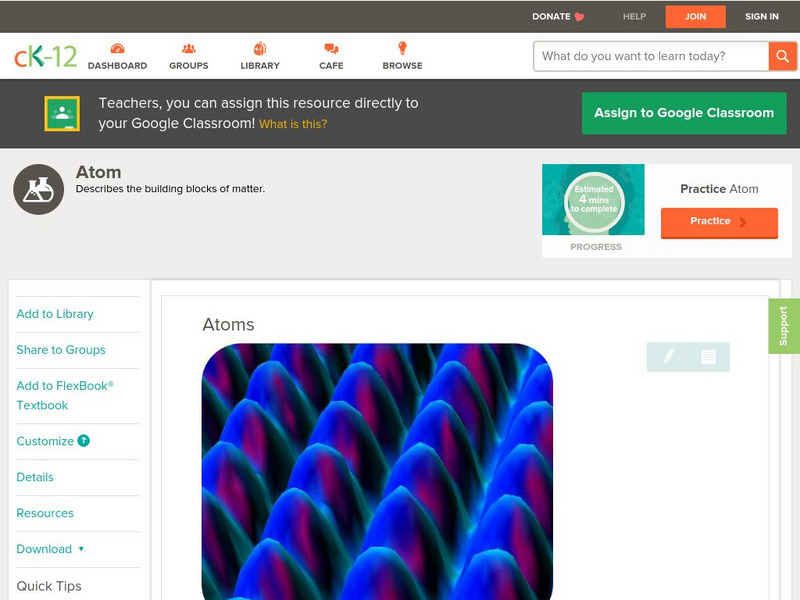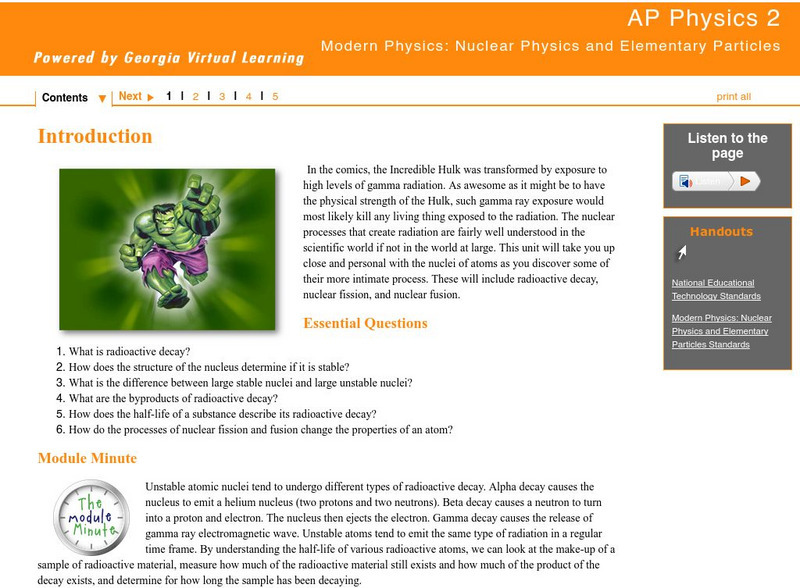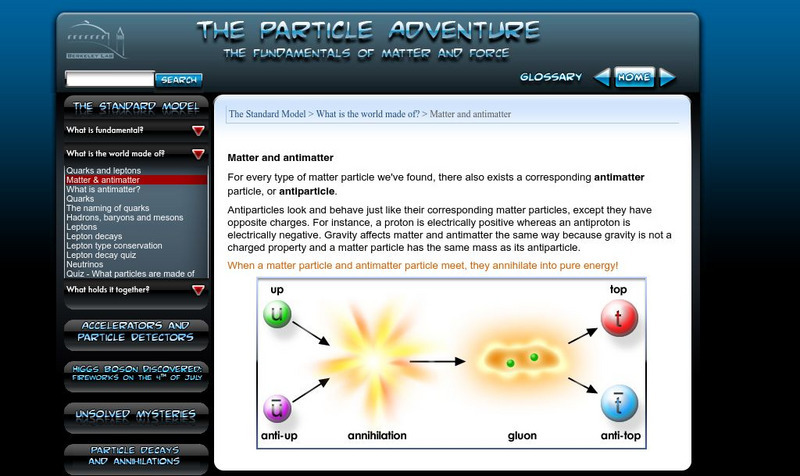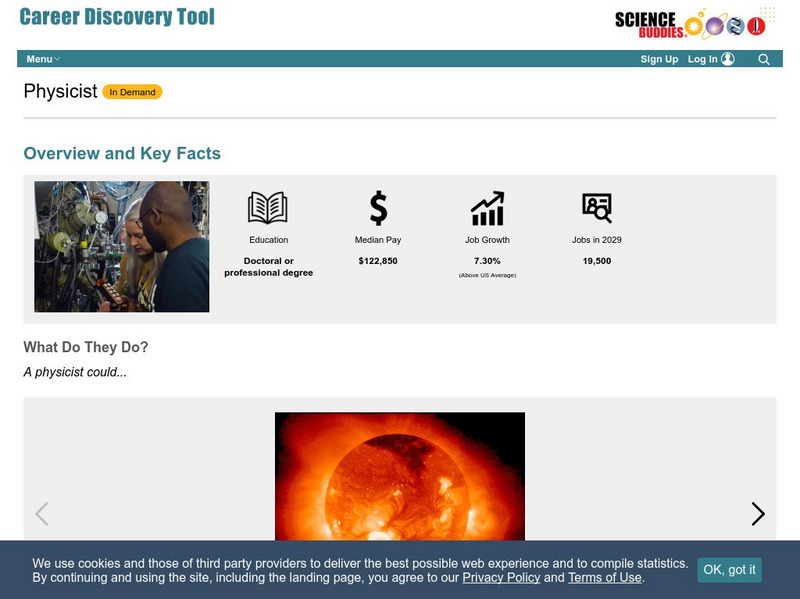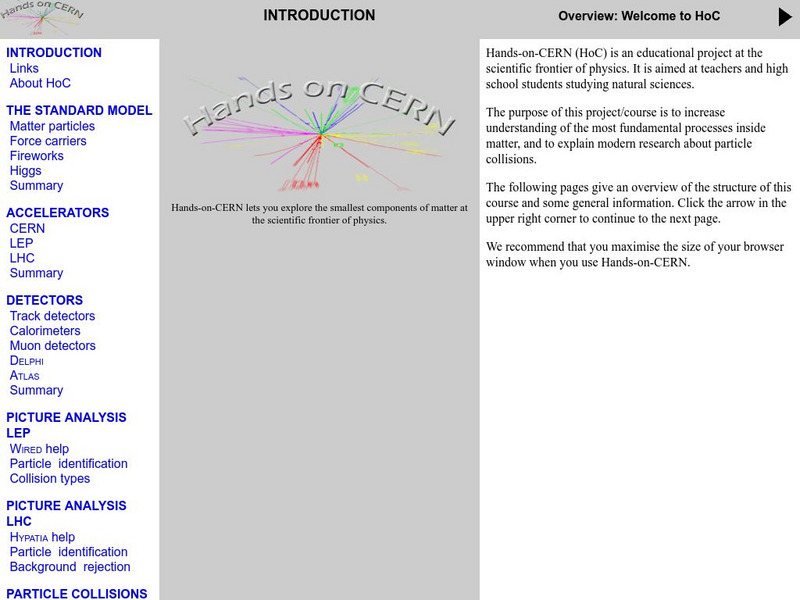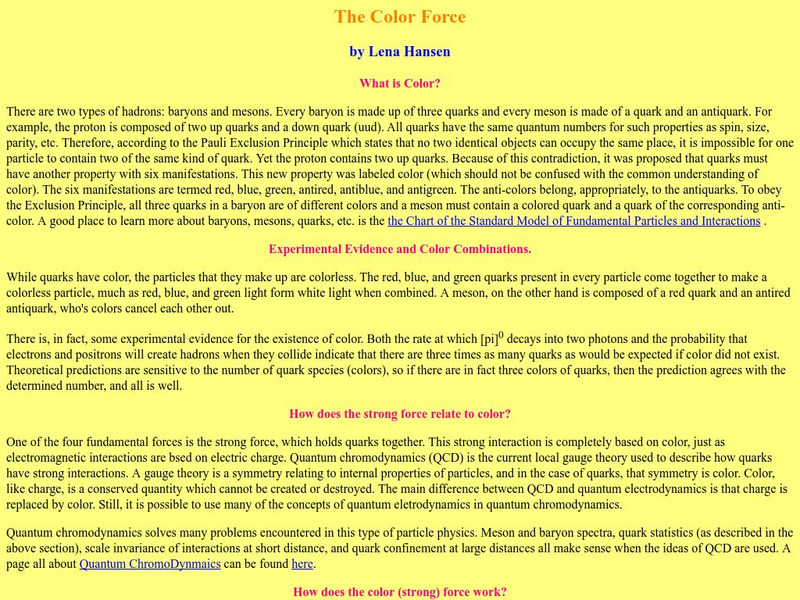CK-12 Foundation
Ck 12: Physical Science: Atoms
[Free Registration/Login may be required to access all resource tools.] Atoms and how they are related to elements, and the particles that make up atoms.
CK-12 Foundation
Ck 12: Physical Science: Atoms
[Free Registration/Login may be required to access all resource tools.] Atoms and how they are related to elements, and the particles that make up atoms.
Other
Manitoba Education and Training: Physics: Particle and Wave Models of Light
A collection of ideas for teaching students about the nature of light. They learn about the history behind theories of light and the contributions of different scientists. Includes lots of experiments to build their understanding of the...
American Association of Physics Teachers
Com Padre Digital Library: Open Source Physics: Particle Worldline Model
Simulation exploring the behavior of particles as they approach a black hole using Schwarzschild coordinates.
TeachEngineering
Teach Engineering: Particle Sensing: The Coulter Counter
Students are presented with a short lesson on the Coulter principle, an electronic method to detect microscopic particles and determine their concentration in fluid. Depending on the focus of study, students can investigate the...
Other
Fermilab: What Are the Basic Forces Between Particles?
Get an introduction to the four forces that interact between atomic particles. With the help of a simulation you'll see how building reconstruction would be affected without each of the forces.
Georgia Department of Education
Ga Virtual Learning: Nuclear Physics and Elementary Particles
This interactive unit will take students up close and personal with the nuclei of atoms as they discover some of their more intimate process. These will include radioactive decay, nuclear fission, and nuclear fusion.
Lawrence Berkeley National Laboratory
Berkeley Lab: Particle Adventure: Matter and Antimatter
The beginning of an informative tutorial on antimatter, covering quarks, hadrons, baryons, mesons, leptons, and neutrinos.
Science Buddies
Science Buddies: Career Profile: Physicist
Physicist as a career is a very broad spectrum. This site from Science Buddies relates the general requirements and education needed to be a physicist and lists the many sub-fields in which physicists can specialize. Included is a video...
Georgia Department of Education
Ga Virtual Learning: Nuclear Physics
Through informational text, interactive activities, and virtual animations students learn about the atomic nucleus, fission, fusion, and radioactive decay.
Other
Hands on Cern: Explore the Smallest Components of Matter
An online course in particle physics with colorful images, charts and animations. Begin by learning about the Standard Model and the types of particles, particle families, and forces, then carry this knowledge over to your study and...
Symmetry Magazine
Symmetry Magazine: Explain It in 60 Seconds: Dark Matter
Dark matter is still quite a mystery to scientists, who hope to learn more about it through experiments with particle accelerators. "Explain It In 60 Seconds" is an article series that aims to summarize in a few paragraphs the meaning of...
Symmetry Magazine
Symmetry Magazine: Explain It in 60 Seconds: Magnet Quench
A magnet quench, explained here, is a routine event that happens within a particle accelerator that can require the accelerator to be shut down for a period of repair, losing valuable research time. "Explain It In 60 Seconds" is an...
Symmetry Magazine
Symmetry Magazine: Explain It in 60 Seconds: Charm Quark
Charm quarks, described in this article, are a type of quark that is basic to matter. A particle with a charm quark deteriorates quickly into a regular particle. A study of these quarks could reveal critical information about matter....
National High Magnetic Field Laboratory
Magnet Academy: Murray Gell Mann
Murray Gell-Mann is a theoretical physicist who won the Nobel Prize for Physics in 1969 for his contributions to elementary particle physics. He is particularly well known for his role in bringing organization into the world of subatomic...
Symmetry Magazine
Symmetry Magazine: Explain It in 60 Seconds: Luminosity
Luminosity, described here, is a scale for measuring how efficiently a collider works. "Explain It In 60 Seconds" is an article series that aims to summarize in a few paragraphs the meaning of different concepts in particle physics.
Symmetry Magazine
Symmetry Magazine: Explain It in 60 Seconds: Neutralinos
Neutralinos, described here, are hypothesized particles of dark matter. Scientists hope to confirm their existence through their research with the Large Hadron Collider. "Explain It In 60 Seconds" is an article series that aims to...
Symmetry Magazine
Symmetry Magazine: Explain It in 60 Seconds: The Higgs Boson
The Higgs boson, a particle hypothesized by Peter Higgs, is described in this article. "Explain It In 60 Seconds" is an article series that aims to summarize in a few paragraphs the meaning of different concepts in particle physics.
Famous Scientists
Famous Scientists: Chen Ning Yang
Learn about the Nobel Prize winning physicist who works on statistical mechanics and particle physics.
Symmetry Magazine
Symmetry Magazine: Explain It in 60 Seconds: The International Linear Collider
The International Linear Collider, when built, will be larger than the Large Hadron Collider near Geneva. A short description is given here. "Explain It In 60 Seconds" is an article series that aims to summarize in a few paragraphs the...
Symmetry Magazine
Symmetry Magazine: Explain It in 60 Seconds: Simulations
Simulations are useful research tools for scientists and save a lot of time and money. Some of the ways they are used are described in this article. "Explain It In 60 Seconds" is an article series that aims to summarize in a few...
Symmetry Magazine
Symmetry Magazine: Explain It in 60 Seconds: The Terascale
The terascale, described in this article, is a subatomic region that requires enormous amounts of energy in order to reach it. Scientists hope to be able to study it with the Large Hadron Collider. "Explain It In 60 Seconds" is an...
Duke University
Duke University: The Color Force
What does color have to do with particle physics? This page explains the concepts of color and the color force, which are fundamental subjects in quantum chromodynamics.
PBS
Nova: The Elegant Universe: Viewpoints on String Theory: Sheldon Glashow
Transcript of an interview with physicist Sheldon Glashow on his attitude toward string theory and its impact on the study of particle physics and cosmology.

